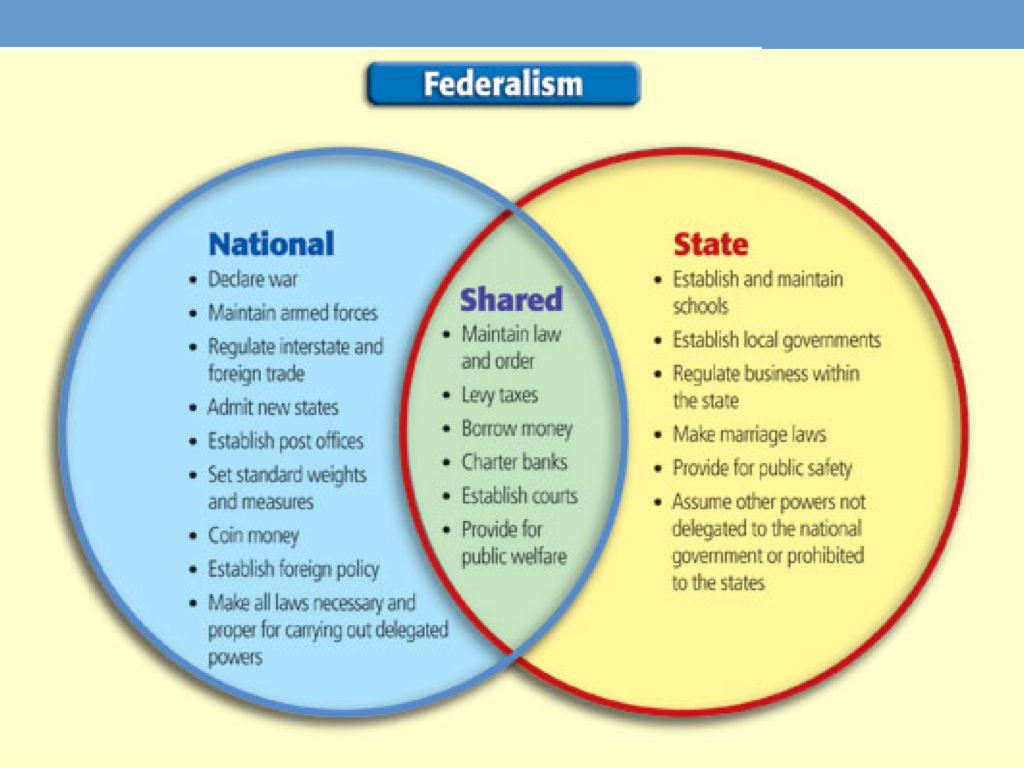Chapter 3: Federalism
Objectives:
Discuss the historical origins of federalism, and explain how it has evolved over time.
- Debates surrounding federalism can be seen in the ratification debates between the Federalists, who wanted a strong central government, and the Anti-federalists, who wanted strong state governments. A federal system of government was ultimately created to balance the powers between the central and state governments, but the balance in the power has fluctuated over time. Today, we see that the federal government has more power and duties to fulfill, but states still have a wide range of policy areas which they have power in. Many Supreme Court cases have reasserted powers in the national government (United States v. Lopez (1995), United States v. Morrison (2000), Printz v. United States (1997)), but many cases have also reasserted powers in the state governments (Saenz v. Roe (1999), Gonzales v. Raich (2005), Arizona v. United States (2002), Obergefell v. Hodges (2015)).
Summarize the pros and cons of federalism in the United States.
- One con of federalism is the lack of equality. Certain policies and programs can be found in some states, but not others. Different policies pop up in different places because different people have different preferences. This leads to people being treated differently depending on their state of residence. One pro of federalism though, is that it allows for more opportunities for participation, since there are different levels of government in which citizens can participate.
Describe how funding underlies federal-state interactions and how this relationship has changed over time.
- Funding is an important part of federal-state interactions. The federal government provides money to the states, who use that money to run various programs. One way is through grants-in-aid. The amount of money the government allocates towards these grants has been increasing over time. Most of these grants were designed to serve state purposes, but slowly the federal government began devising grant programs less on what states wanted and more on what the federal officials perceived to be important national needs.
Discuss whether the devolution of programs to the states beginning in the 1980s really constitutes a revolution in federal-state relations.
- In the 1980s, the federal government devolved many programs to the states. Prior to this devolution, the federal government held more of the power in terms of social welfare programs and other services. However, with devolution, this power shifted to the states, which now have more control over these programs. However devolution has led to more government rules and regulations, not less. States have enacted rules of their own but have also prompted the federal government to issue new rules on matters, such as environmental protection. One challenge with states assuming more responsibilities for public programs is the lack of funding due to budget shortfalls and mounting debt.
Why Federalism Matters:
- Modern day concerns about federal-state relations
- Ex: Obamacare, Medicaid
- Federalism is a political system where the national government shares power with local governments
- Founders used federalism to protect individual rights
- Feared that concentrating power was a risk to tyranny.
- Founders envisioned that the national and state powers would not have supreme authority over the other.
- Hamilton thought the national government was superior, and its powers should be broadly defined.
- Jefferson thought the federal government was a product of an agreement among the states. Threat to liberties will come from the national government.
Dual to Cooperative Federalism:
Issues with dual surrounding commerce. Where does the line for interstate and intrastate commerce stop and start?
- Slowly transitioned into cooperative federalism, where powers between the state and federal government overlapped

State Sovereignty:
- Many Court cases that are reasserting a greater role for state power
- United States v. Lopez (1995), United States v. Morrison, Printz v. United States (1997)
- Court cases also reassert national power
- Saenz v. Roe (1999), Gonzales v. Raich (2005), Arizona v. United States (2002), Obergefell v. Hodges (2015)
Governmental Structure:
- Existence of independent state and local governments means different political groups can come to power in different places.
- Smaller the political unit, the more likely it is to be dominated by a single faction.
Different States, Different Policies:
- States serve as laboratories of democracy.
- Experimentation has a cost: citizens are treated differently depending on their state of residence
- Policies differ because different people have different preferences
- Benefit: more opportunities for participation
Grants in Aid:
- Cash grants-in-aid began pretty early, in 1808. Congress gave $200k to help with militias.
- Today federal grants go to hundreds of programs.
- Grew rapidly because it helps state and local governments solve dilemmas.
- During the 1960s. The government began devising grant programs less on what states were demanding and more on what the federal officials deemed to be important national needs.
Categorical Grants:
- Block grants supposed to give states freedom to divide how to spend the money, however there were some issues:
- Amount of money available did not grow as fast as the states hoped
- Federal government increased number of strings attached
- Grew more slowly than categorical grants
- Cover a broad range of activities that no single interest group has a vital stake in.
Federal Aid and Federal Control:
- Two kinds of federal control on state governmental activities:
- Conditions of Aid: what states need to do if they want grant money
- Mandates: what states must do, period
- Most mandates have little or nothing to do with federal grants
- Most concern civil rights and environmental protection
Devolution Revolution:
- Want to scale back the power of the national government by giving more power to the states
- Started with Reagan in the 1960s